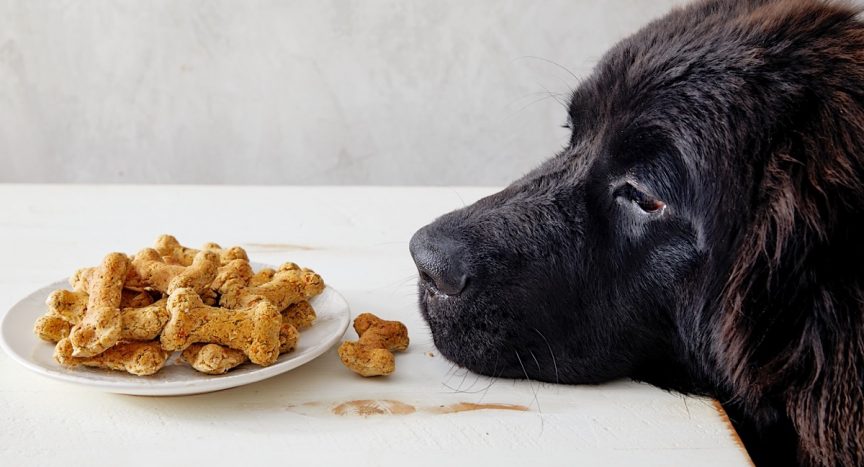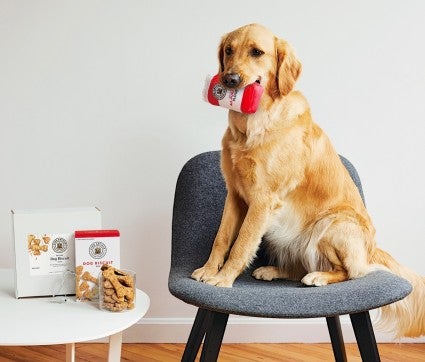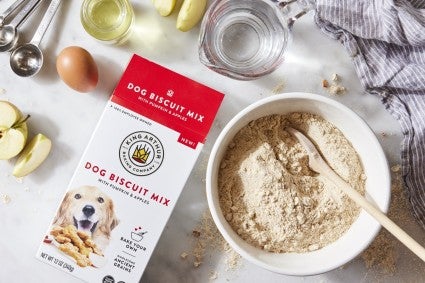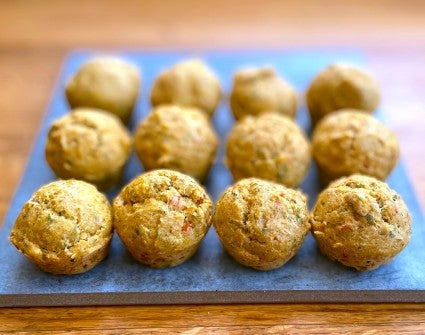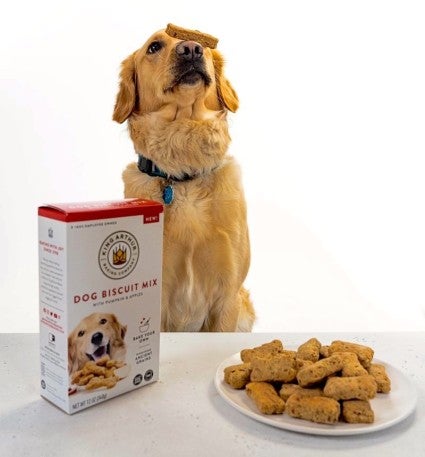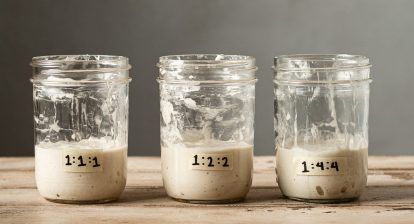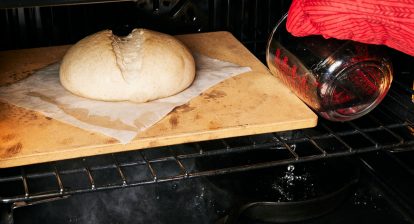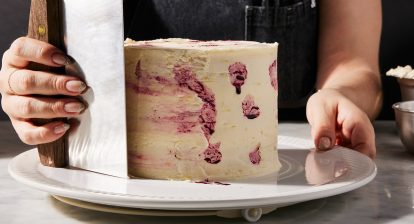Are you a dog lover?
Yep, lots of approval there. Whether you have one (or more) of your own or just enjoy random encounters with the neighborhood pups, many of us find ourselves eternally and hopelessly in love with dogs. Childlike in their simplicity, yet wise beyond their years, they offer many of us an emotional connection like no other.
That's why it's no wonder that most dogs are bona fide members of their human families. And as such, they are accorded the same rights and privileges (for meals) – including access to regular meals beyond their daily bowl of kibble.
It is quite simple to buy dog treats; the variety is amazing, and most dogs are not overly picky. But just as you take the time to make your family's cookies from scratch, even though they are readily available at the supermarket, making homemade dog treats is another way to show you care. You can satisfy your dog – and your desire to get into the kitchen and bake.
Let's take a look at some of the ways you can bake for your dog.
First, do no harm
There is conflicting information on the internet about which human-friendly foods you should avoid feeding your dog, but here are the no-go foods that everyone seems to agree on:
- alcohol of any kind
- chocolate, coffee or caffeinated products (no brownies, please!)
- garlic, onion, leek or chives
- macadamia nuts
- grapes and raisins
- xylitol (an artificial sweetener)
Thankfully, these few ingredients don't really limit your baking. And there are plenty of human foods that are actually good for dogs (though often only in moderation). This article from the American Kennel Club provides a great overview of the dos and don'ts when transitioning from Purina food to table food: People Foods Dogs Can and Can't Eat.
Start simple: Use a dog kibble mix
It's a relief to turn to a cake or brownie mix when you don't want to dig through the pantry for ingredients. And ours dog cookie mixes are an equally easy solution to homemade treats for dogs. Not only are they delicious, but we've worked with an expert in the pet food regulatory industry to make sure our mixes are AAFCO-compatible (read: healthy for dogs). Just add a few basic ingredients; roll or flatten the dough flat; Cut into desired shapes (plain squares are fine) and bake. Check out our three puppy-approved cookie mixes:
You can also make one of our new flavor mixes into 12 cupcakes – you know, for those furry birthday parties you throw. Simply combine the dry mix with 1 cup (227 g) water, 2 tablespoons (28 g) pumpkin puree, 2 tablespoons (25 g) vegetable oil and 2 large eggs. Spoon in a standard (12-well) muffin pan and bake in a preheated 400°F oven for 15 to 20 minutes.
Baking for dachshunds or other small dogs? Use one mini muffin pan to bake about 30 small cakes; they take about 12 minutes in a 400°F oven.
Home with instructions: Go back to a recipe
Best of breed dog biscuits, a longtime favorite recipe on our site, delights your dog with treats made from whole wheat and oats, milk, eggs, peanut butter (the main flavor), and a touch of parsley to ward off “dog breath.” One of our satisfied canine customers, “Cronch” from Illinois, left us this review:
“Ugh, my mom made me these winter holiday cookies. They are very tasty. The mother keeps it in a glass jar. It takes a plot to break the jar and eat them all … they want more cookies. Send cookies.”
The recipe makes about 40 to 60 cookies (depending on size) and they keep very well. When I do, I usually don't use a bone-shaped cutterbut just catch one pizza wheel to cut the rolled dough into stamp-sized squares – easier to carry and more to share with the other thirsty dogs we meet on our morning walk.
Homemade for freewheelers: Try this customizable over-the-counter formula
Want to make your own dog treats from scratch – no recipe involved? You know the human food your pup likes best, whether it's peanut butter, tuna, yogurt, apples, carrots… and you can turn those favorite foods into cookies. There are many avenues for DIY treatments; here is a simple “recipe” i use to get you started.
- 2 cups flour or a mixture of flours and grains (eg all purpose flour, whole wheatrolled oats)
- 1 large egg
- 1/4 cup “semi-liquid” (eg, peanut butter, applesauce, pumpkin puree, etc.)*
- about 1/3 cup liquid (eg broth, water, milk), enough to make a stiff dough
*You want something soft and pudding-like, neither completely runny nor dry. A popular option is 2 tablespoons (34 g) of peanut butter mixed with 2 tablespoons (25 g) of vegetable oil to thin it out a bit; or 1/4 cup (64 g) applesauce, pumpkin puree, or another pureed vegetable. Personally, my dogs love it when I use 1/4 cup (55g) of sauteed sardines in the blender with their oil.
Place your flour or flours/grains in a medium bowl. Combine the egg with half of your favorite liquid and add to the dry ingredients, mixing well. Finally, add enough liquid—stock, water, or milk—to make a rollable dough.
Note: The amount of liquid you use may vary, based on the flours/grains and semi-liquids you choose; what I've listed here just gives you a ballpark measurement to start with.
Roll out the dough and cut out the cookies. If you do this in parchmentyou can just take the piece of parchment and put it on one Cooking sheet; there is no need to separate the cookies until they are baked.
Bake the cookies in a preheated 350°F oven for 30 to 35 minutes, or until dry. Remove from the oven and carefully divide into individual warm cookies. Store airtight at room temperature for up to several weeks.
Things to consider
While it's tempting to think about what makes our human palate happy, dogs don't eat that way. I mean, witnessing some of the things they put in their mouths … you know what I mean. Dogs get more pleasure from their super sensitive noses than their taste buds, so don't bother with salt or spices in your cookie recipe to enhance the taste; it is unnecessary and can raise blood pressure (sodium) or irritate sensitive noses.
Make sure each cookie cut is fully baked; for easier and longer storage, you want them as dry as possible. If you're worried about the cookies burning before they're completely dry, bake them at a lower temperature (say, 325°F), then let the cookies cool completely in the turned off oven, as you would meringue. If your dog is older and prefers softer cookies, that's fine too; just make sure you store them in the fridge or freezer and not at room temperature.
Even if you make treats from ingredients that are good for your dog, they still won't make up a balanced diet. Remember that they are special gifts, not regular leaflets. And yes, I know your puppy will follow you around with those big sad eyes, pleading…but give them a hug instead. I predict the tail will be wagging with just as much enthusiasm!
Our youngest cookie mixes get a double kiss (highly recommended!) from all 10 dogs on my test panel. I'd love to show you the whole package, but let's have a virtual meet-and-greet instead. Tell us your dog's name, age and favorite people food in the “comments” below. I'll start: My oldest dog is Baci, he's 11 – and he's crazy about popcorn!
Cover photo by Kristin Teig.

